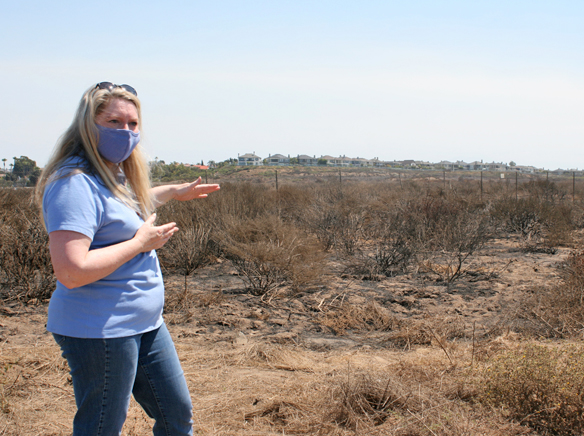
On July 26, a scorching brush fire consumed more than 62 acres of the Bolsa Chica Ecological Reserve. The fire burned for approximately two hours, destroying nearly everything on top of the soil.
The Bolsa Chica Land Trust Executive Director Kim Koplin explains that the quick spread of the fire was aided by non-native European grass on the upper mesa. When dried up, this grass forms a thick ground covering known as “thatch.” The thatch provided a fuel source that allowed the fire to spread quickly.
“This place went up like kindling,” Koplin said.
During the fire, both native and non-native plants were destroyed, leaving the ground barren and charred. But the fire was contained on the upper mesa and spread away from the water. Fire fighters were able to work from the homes at the top of the hill and fight the fire as it approached the houses.
The Bolsa Chica Wetlands provide a trail bubbling with life, but this natural preserve holds more purpose when you look at it microscopically. This mesa’s main purpose is to preserve wildlife, protecting 23 endangered species with no other habitation options, creating as much oxygen as a rainforest, nursing native plants, insects, and fish, and providing mutualism between many plant and animal species with its diverse terrain.
The wetlands are home to snakes, coyotes, lizards, rodents, birds, and more. One of its endangered species, the Southern Tar Plant, nurtures native bees and its population has been increased by the Bolsa Chica Land Trust (BCLT) who planted 15,000 of its flowers. The Belding Stella Sparrow is another endangered species that the BCLT is protecting by keeping people away from the water’s edge during its nursing periods. The Bolsa Chica Wetlands are a fragile territory that offers an equilibrium upon which the survival of its wildlife depends.
The fire was the biggest in a century at the Bolsa Chica Wetlands and it started from the public trail and moved towards the Brightwater Community in less than 20 minutes. Thanks to surrounding fire departments much of the wildlife survived and no houses or residents were harmed.
“We found some crispy critters, but not many,” Koplin said.
Despite the damage it caused, this huge fire created unique restoration opportunities by destroying non-native plants, such as the European grass that was left over from when people farmed the land. The soil was preserved for the native plants, and the fire left behind organic ash which aids in restoration.
“Ash generated by the fire is good, organic material that will aid the restoration of our plants,” Koplin said.
Non-native plants provide no nutritional value to natural wildlife which means the fire has already completed the first step of restoration by ridding the area of invasive plant species. But it is difficult to determine how much of the non-native plants will return when rain arrives.
However, Bolsa Chica Land Trust volunteers will have a chance to try and contain the growth of non-native plants and increase native plants. The BCLT is working with scientists from UC Irvine to try and predict which plants are likely to return in larger numbers. Koplin said they are pulling in experts from as many organizations as they can get.
“Because, we’ve never had to deal with this,” Koplin said.
The BCLT’s restoration goal is to provide pristine survival conditions for its treasured wildlife by planting more native plants to nourish these animals. The timeframe for this “emergency restoration” is from now until April 2021 before the non-native plants return and begin taking over the native plants’ territory. But it will need to be done in phases, as needs arise.
The BCLT will be accepting help financially and through volunteer opportunities. For more information, visit bclandtrust.org, or call 714-846-1001. More information on the wetlands is also available at bolsachica.org and amigosdebolsachica.org.
Siena Odrich is a junior at Los Alamitos High School
Kayla Tracy is a sophomore at Los Alamitos High School



